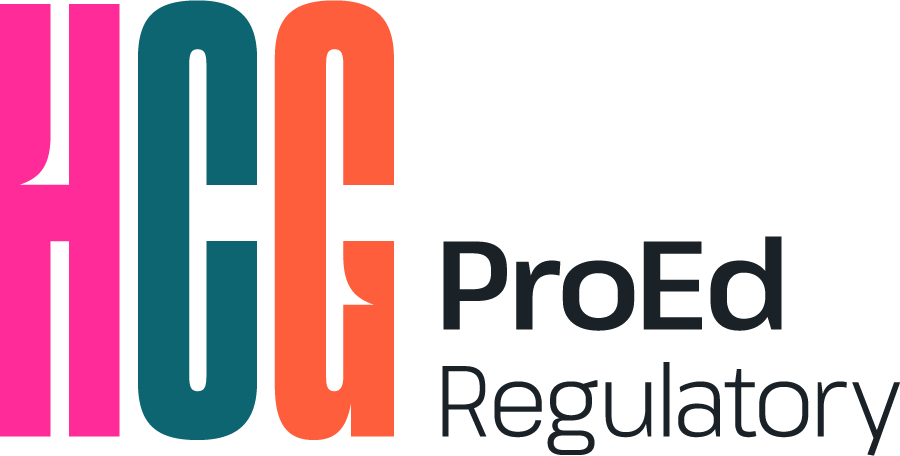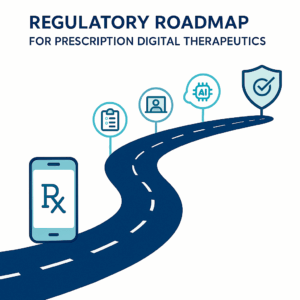Navigating the Regulatory Landscape of Prescription Digital Therapeutics (Part 2)
In our first installment, we explored the rapidly evolving world of digital health therapeutics (DTx),1 which are innovative, evidence-based software solutions that go far beyond wellness apps to deliver clinically meaningful outcomes for patients. We discussed the distinctions between prescription and non-prescription DTx, highlighted real-world examples, and discussed the significant benefits DTx offer in terms of accessibility, patient engagement, and healthcare cost savings. As adoption accelerates and the evidence base grows, it’s increasingly important to understand the regulatory landscape that ensures these technologies are both safe and effective.
In this next installment, we take a deeper dive specifically into how prescription digital therapeutics (PDTs) are regulated, examine the FDA’s approval pathways for these products, and unpack the clinical trial designs and evidence requirements shaping the future of digital medicine.
What Makes Prescription Digital Therapeutics Unique in the Regulatory Context?
PDTs are designed to deliver direct therapeutic benefit for diagnosed medical conditions and stand apart in the regulatory world due to their higher risk profile and the requirement for a healthcare provider’s prescription, differentiating them from general wellness apps or nonprescription digital health products.2 Because these software-based treatments are intended to have a significant impact on patient health, they must meet the FDA’s high regulatory standards. This includes not only demonstrating efficacy and safety through robust clinical trials but also ensuring data privacy, secure prescription mechanisms, and ongoing postmarket monitoring.
Rigorous regulatory oversight is essential because PDTs can directly affect treatment decisions, influence disease progression, and even pose risks if used incorrectly. The FDA’s thorough review process includes assessment of clinical data, software reliability, cybersecurity, and real-world performance and helps protect patient safety while fostering innovation in this fast-moving field.
Rigorous regulatory oversight is essential because PDTs can directly affect treatment decisions, influence disease progression, and even pose risks if used incorrectly.
As PDTs continue to expand across therapeutic areas, this robust regulatory framework remains a cornerstone for building trust and ensuring positive health outcomes.
FDA Regulation of PDTs
The FDA regulates these products under its Software as a Medical Device (SaMD) framework, which covers software intended for medical purposes without being part of a hardware medical device. This framework requires evidence similar to that demanded of other medical devices, and it ensures that PDTs deliver consistent, reliable outcomes and that patients and providers can trust in their therapeutic claims.3,4 The FDA puts medical devices, including PDTs, into risk categories, and most PDTs fall into Class II (moderate risk).3-5 In terms of regulatory pathways, the majority of approved PDTs were cleared through the 510(k) pathway, which requires demonstrating that the new device is “substantially equivalent” to a legally marketed device in terms of safety and efficacy.1,6 Truly novel digital therapeutics instead go through the De Novo pathway, where no “predicate” device exists.1,7
Finally, the FDA expects PDT developers to meet clinical evidence standards. For example, PDTs must prove they deliver real therapeutic benefits (efficacy) and do not pose undue risks (safety).8 In terms of human factors and patient engagement, usability testing is also crucial, especially for digital tools that patients use independently. The design must account for human factors, including how patients interact with the software or device, and maximize engagement while minimizing user error.9
PDTs must prove they deliver real therapeutic benefits (efficacy) and do not pose undue risks (safety).
Next, with sensitive health data at stake, robust security and privacy controls are nonnegotiable, and the FDA has issued specific guidance on managing cybersecurity risks for medical devices.10 Finally, PDTs must have clear labeling so providers and patients understand how, when, and for whom the product should be used. As prescription products, PDTs are distributed through controlled channels and require provider oversight.
Clinical Trials and Evidence Generation for PDTs
Now, let’s explore how clinical trials are designed for these types of products. The FDA’s expectations for PDTs are high, but the flexibility of digital platforms has also led to exciting new approaches in clinical trial design and real-world data collection.
Randomized controlled trials (RCTs) remain the gold standard for demonstrating efficacy and safety. Participants are randomly assigned to receive either the PDT or a control (such as a sham device, standard care, or placebo app), helping to ensure unbiased results. For example, the pivotal trial for the initial approval of EndeavorRx® for pediatric attention-deficit hyperactivity disorder (ADHD) was a multisite RCT that showed significant improvement in its primary endpoint, an objective measure of attention, compared to a digital control intervention.11 This study also assessed safety, demonstrating that this PDT was well tolerated, with low rates of adverse events (AEs) that were mainly mild and included frustration and headache, with no severe AEs or discontinuations.11 In addition to RCTs, which typically involve in-clinic visits, digital therapeutics are uniquely suited to decentralized clinical trials (DCTs), where participants enroll, consent, and complete study activities entirely from home.12 This model was especially valuable during the COVID-19 pandemic and remains highly desirable for PDT developers. DCTs can speed up recruitment, increase diversity, and lower costs, while collecting real-world data in natural settings.13
Trials investigating PDTs often leverage digital endpoints and collect data directly from the software. This could be time spent on therapeutic activities or engagement with specific features, as well as patient-reported outcomes (PROs) captured through in-app surveys. These endpoints allow for continuous, real-world assessment of behavior changes, symptom improvement, and quality of life. The FDA encourages the thoughtful use of digital health technologies for objective and patient-centric endpoints.12,13
Similar to traditional pharmacotherapies, the regulatory journey for PDTs doesn’t end with approval. The FDA and developers increasingly rely on real-world evidence (RWE) from postmarket studies, ongoing monitoring, and user data to confirm continued effectiveness and safety. For example, following the FDA approval of Somryst® for chronic insomnia in adults, a study was conducted to assess the benefits of treating chronic insomnia in a real-world setting.14 This large, US-based, DCT demonstrated reasonably similar results to the initial trials used for FDA approval, preserving the large effect size and confirming improvement in insomnia severity in a real-world setting.14 Ongoing monitoring and RWE may be especially important for PDTs with software that evolves using artificial intelligence (AI), such as the recently approved Felix NeuroAI wristband for adults with essential tremor.15 This wearable device uses patient movement data and neural recordings to personalize therapy in real time via a cloud-based AI platform, an example of innovation coming in the next generation of PDTs.
Key Takeaways: Present and Future
As PDTs continue to transform the healthcare landscape, it’s clear that robust regulatory frameworks, rigorous clinical evidence, and ongoing collaboration between developers and regulators are vital. With these innovative trial designs, digital endpoints, and ongoing real-world evaluation, PDTs are setting a new bar for evidence in digital health. The FDA’s standards ensure these products are not only cutting-edge, but also trusted and credible tools for patients and providers alike. Importantly, the FDA has shown its dedication to collaborating with industry on ongoing digital health innovation and recently launched a Regulatory Accelerator that provides tailored FDA resources designed to address the specific informational needs of digital health innovators.16 Join us in our next installment of this series, where we discuss evolving challenges and the future of PDT regulation.
Kathryn M. Madalena, MS, PhD
Assistant Scientific Director, Scientific Services
Kathryn helps Sponsor teams prepare for regulatory interactions and FDA advisory committee meetings by leading scientific content development while integrating key strategic imperatives. She brings her passion for communication to her project support across a broad range of therapeutic areas, with specialized expertise in oncology, psychiatry, and neurology.
Connect with Kathryn on LinkedIn.
References
- Orabone J. Unlocking the Potential of Digital Health Therapeutics: FDA-Approved Solutions for Modern Healthcare [blog post]. June 23, 2025. https://proedcomblog.com/2025/06/23/unlocking-the-potential-of-digital-health-therapeutics-fda-approved-solutions-for-modern-healthcare/
- Lakhan SE. Decoding FDA Labeling of Prescription Digital Therapeutics: A Cross-Sectional Regulatory Study. Cureus. 2025;17(5):e84468. doi:10.7759/cureus.84468
- US FDA. Software as a Medical Device (SaMD). 2018. https://www.fda.gov/medical-devices/digital-health-center-excellence/software-medical-device-samd
- Watson A, et al. FDA regulations and prescription digital therapeutics: Evolving with the technologies they regulate. Front Digit Health. 2023;5:1086219. doi: 10.3389/fdgth.2023.1086219.
- US FDA. Classify Your Medical Device. 2020. https://www.fda.gov/medical-devices/overview-device-regulation/classify-your-medical-device
- US FDA. Premarket Notification 510(k). 2024. https://www.fda.gov/medical-devices/premarket-submissions-selecting-and-preparing-correct-submission/premarket-notification-510k
- US FDA. De Novo Classification Request. 2022. https://www.fda.gov/medical-devices/premarket-submissions-selecting-and-preparing-correct-submission/de-novo-classification-request
- US FDA. Software as a Medical Device (SAMD): Clinical Evaluation. Guidance for Industry and Food and Drug Administration Staff. 2017. https://www.fda.gov/media/100714/download
- US FDA. Applying Human Factors and Usability Engineering to Medical Devices. Guidance for Industry and Food and Drug Administration Staff. 2016. https://www.fda.gov/regulatory-information/search-fda-guidance-documents/applying-human-factors-and-usability-engineering-medical-devices
- US FDA. Cybersecurity. 2025. https://www.fda.gov/medical-devices/digital-health-center-excellence/cybersecurity
- Kollins SH, et al. A novel digital intervention for actively reducing severity of paediatric ADHD (STARS-ADHD): a randomised controlled trial. Lancet Digit Health. 2020;2(4):e168-e178. doi: 10.1016/S2589-7500(20)30017-0.
- US FDA. Digital Health Technologies for Remote Data Acquisition in Clinical Investigations. Guidance Document. 2023. https://www.fda.gov/regulatory-information/search-fda-guidance-documents/digital-health-technologies-remote-data-acquisition-clinical-investigations
- US FDA. The Evolving Role of Decentralized Clinical Trials and Digital Health Technologies. 2023. https://www.fda.gov/drugs/cder-conversations/evolving-role-decentralized-clinical-trials-and-digital-health-technologies
- Thorndike FP, et al. Effect of a prescription digital therapeutic for chronic insomnia on post-treatment insomnia severity, depression, and anxiety symptoms: results from the real-world DREAM study. Front Psychiatry. 2024;15:1450615. doi: 10.3389/fpsyt.2024.1450615.
- George J. FDA Clears AI-Powered Wearable for Essential Tremor. MedPage Today. July 2, 2025. https://www.medpagetoday.com/neurology/generalneurology/116351?xid=nl_mpt_morningbreak2025-07-02&mh=8b1ab7e2fb505f6260038f464b37d838&zdee=gAAAAABm4u3q6I43s_Gu22VYnDEEmoeSTQfj7n7J_G7b6tttY4laYKDMDNdPnJHvL6HcPwHm9N1iOM9WXB3UIqt-_bZ8_aWZQsOR8uuoq5ECsVwMixsW-5I%3D&utm_source=Sailthru&utm_medium=email&utm_campaign=MorningBreak_070225&utm_term=NL_Gen_Int_Daily_News_Update_active
- US FDA. Regulatory Accelerator. 2025. https://www.fda.gov/medical-devices/digital-health-center-excellence/regulatory-accelerator


